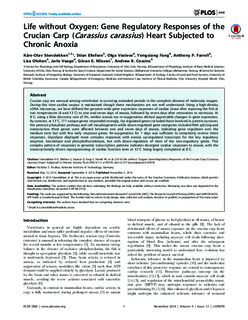Life without Oxygen: Gene Regulatory Responses of the Crucian Carp (Carassius carassius) Heart Subjected to Chronic Anoxia
Stensløkken, Kåre-Olav; Ellefsen, Stian; Vasieva, Olga; Fang, Yongxiang; Farrell, Anthony P.; Olohan, Lisa; Vaage, Jarle; Nilsson, Göran E.; Cossins, Andrew R.
Journal article, Peer reviewed
Permanent lenke
http://hdl.handle.net/11250/275535Utgivelsesdato
2014Metadata
Vis full innførselSamlinger
Originalversjon
Stensløkken K-O, Ellefsen S, Vasieva O, Fang Y, Farrell AP, Olohan L, et al. (2014) Life without Oxygen: Gene Regulatory Responses of the Crucian Carp (Carassius carassius) Heart Subjected to Chronic Anoxia. PLoS ONE 9(11): e109978. 10.1371/journal.pone.0109978Sammendrag
Crucian carp are unusual among vertebrates in surviving extended periods in the complete absence of molecular oxygen. During this time cardiac output is maintained though these mechanisms are not well understood. Using a high-density cDNA microarray, we have defined the genome-wide gene expression responses of cardiac tissue after exposing the fish at two temperatures (8 and 13uC) to one and seven days of anoxia, followed by seven days after restoration to normoxia. At 8uC, using a false discovery rate of 5%, neither anoxia nor re-oxygenation elicited appreciable changes in gene expression. By contrast, at 13uC, 777 unique genes responded strongly. Up-regulated genes included those involved in protein turnover, the pentose phosphate pathway and cell morphogenesis while down-regulated gene categories included RNA splicing and transcription. Most genes were affected between one and seven days of anoxia, indicating gene regulation over the medium term but with few early response genes. Re-oxygenation for 7 days was sufficient to completely reverse these responses. Glycolysis displayed more complex responses with anoxia up-regulated transcripts for the key regulatory enzymes, hexokinase and phosphofructokinase, but with down-regulation of most of the non-regulatory genes. This complex pattern of responses in genomic transcription patterns indicates divergent cardiac responses to anoxia, with the transcriptionally driven reprogramming of cardiac function seen at 13uC being largely completed at 8uC.
